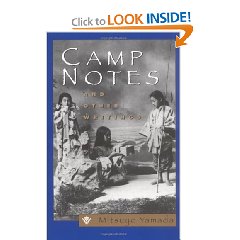I was browsing the American Literary History Journal the other day and came across Corinne E. Blackmer’s “Writing Poetry like a ‘Woman’.” In it, I found this observation on the subject of writing by incarcerated Japanese American women during World War II:
The experience of these [internment] camps radically affected the writing of issei and nisei women poets. Before the war, issei values of feminine propriety confined women to the household and prohibited public discourse; the experience of the camps, however, blurred men and women into a shared common world. (134)
Though Blackmer makes an interesting claim about the impact of changed spatial and social relations on “the writing of issei and nisei women poets,” I was most intrigued by the mere existence of the term “issei and nisei women poets.” I was struck for two reasons. First, I realized that I know virtually nothing of “issei and nisei women poets,” nor of the writing they did before or after the war. Second, to see the phrase “the writing of issei and nisei women poets” in print, in an academic literary journal, was shocking. I had never thought of “the issei poet,” or “the nisei poet” as real figures in the history of American literature though I had certainly wondered what they might say. It goes without saying that this realization has prompted me to search out some of these key figures.
Mitsuye Yamada, who wrote the book Camp Notes and Other Poems (Shameless Hussy Press, 1976),* during and shortly after the internment, is one of the poets mentioned in Blackmer’s article, whose voice comes to the reader with great force and a radical vision. In the poem “Neutralize” she writes:
white floors walls ceiling white
white chairs tables sink white
only when I close my eyes do I see
beyond the white windowless walls
The poem, which opens with an epigraph stating “poetry… / has been my spiritual guide / throughout my incarceration,” details the speaker’s resistance to an outside “They’s” attempt to “kill / the sentient being in me,” that is, the seeing, smelling, tasting, touching, and hearing self. Her strong and forceful diction, repetition of the word “white,” and conflation of objects, surfaces, and imagined/actual realities makes for a compelling first encounter with a group of writers with whom I am only just becoming acquainted.
One of Yamada’s earlier poems from Camp Notes, which I also found compelling, constructs an issei voice through the use of fragmented, non-standard English free verse. I found this gratifying because this mode validates some of my own experiments with Japanese American “dialect” or “accented” writing. An excerpt from “Marriage Was a Foreign Country”:
When we land the boat full
of new brides
lean over railing
with wrinkled glossy pictures
they hold inside hand
like this
so excited
down there a dock full of men
they do same thing
hold pictures
look up and down
like this
they find faces to
match pictures.
In this poem, the speaker’s gaze is turned forward toward a future in America, a country as foreign to the new bride as that of marriage (as indicated by the title). The speaker, freshly delivered to an alien shore and tinged by her departure from Japan, brings with her the language of a person newly acquiring a foreign tongue. Returning to this voice, or listening to the traces of it embdedded still in the Japanese American community, is a curious reversal of history and generational assimilation, and therefore one I find tremendously interesting.
I appreciate Yamada’s poem because it does for me something that I am unable to do for myself: imagine what a voice shrouded by time and, to a certain extent, cultural taboo (as many Japanese Americans have, through the generations after WWII, worked to shed their accents and mother tongue), might sound like. Because much of Japanese America’s history has been an effort to make the assertion that “I am an American” (as seen in the Dorothea Lange photograph below), to evoke a “non-American,” or non-standard English voice is a risky move. As always, more to come…

____________________________________________________
* Now available as Camp Notes and Other Writings (Rutgers University Press, 1998)
